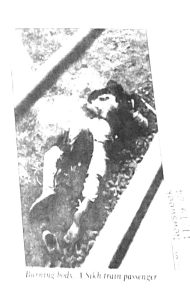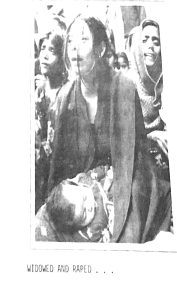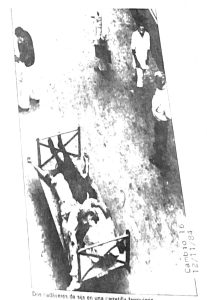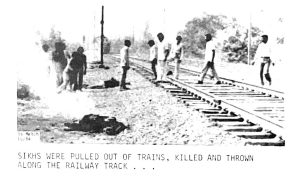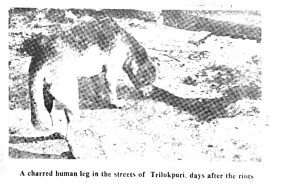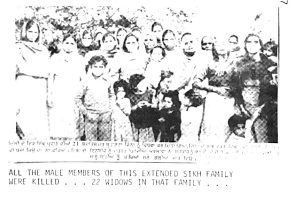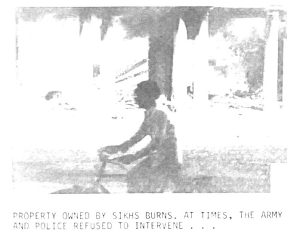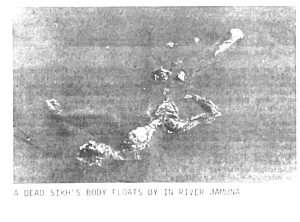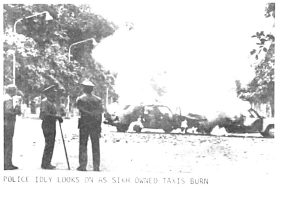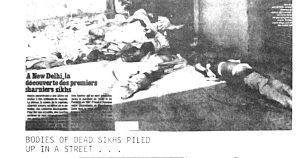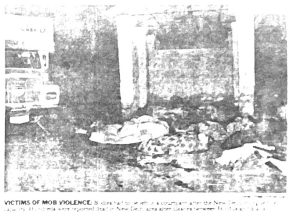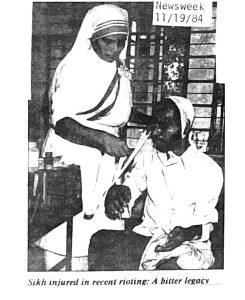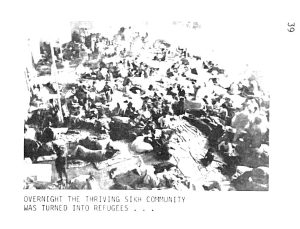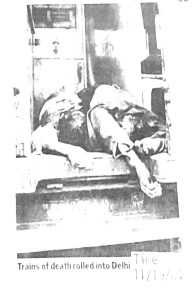Mind-Numbing Tragedy
Another tragedy was soon to overtake the Sikh minority community. In the wake of political assassination of Mrs Indira Gandhi by two of her trusted and long serving personal body guards, who happened to be Sikhs, unprecedented and barbaric violence and arson followed in Delhi and other parts of India against Sikhs In the words of Dharama Vira, Principal Secretary to India’s first Prime Minister Nehru and former Governor, “While Delhi was numbed by shock and sorrow, a wild frenzy of terror, murder, loot and arson seized large sections of the city. Its prime target was a minority community (Sikhs) In large parts of the country the violence spread in varying degrees of intensity, shaking faith in our secularism not only on the part of the afflicted community, but also of other minorities… the administration appeared to have been totally paralyzed for three critical days while hordes of hooligans bent on loot, rapine, murder and arson held free sway.” 73
“All human life obliterated: Civilization broke down at Sikh colony near Delhi” – this is how Los Angeles Times reported the calamity that overtook the Sikh minority community and went on to write: “When the history is written of the horrors that followed the assassination of Indira Gandhi, the 32nd block of Trilokpuri Colony will be remembered as a place where civilization disintegrated “74 Washington Post wrote when historians scrutinize the inhumanness that Swept through India for four long days. it may become a benchmark.75 This was the worst violence since India became independent in 1947 Suddenly the 1947 memories of mindless killing, rape, loot, trains of death and more came alive.
Spontaneous Grief and Anger or Pre-planned Carnage
There have been suggestions that there was a pre-planned conspiracy to wreak revenge on Sikhs because of the recent happenings in Punjab. The authorities believe that it was an instinctive and natural expression of wrath and agony on the part of people at Mrs Gandhi’s assassination and that the Government tried its best to bring the difficult situation under control. Further, that the administration provided protection to the life and property of the minority community wherever possible with its already overtaxed resources and succeeded in re-establishing law and order in a short span of time. The three independent investigations – of Chief Justice Sikri, Professor Rajni Kothari and Manus, found that the uniformity in the Sequence of events at every spot even “at far flung places proved beyond doubt that the attacks were master-minded by some powerful organised groups. Newspaper reports suggest that this pattern is similar in all Congress (I) ruled states.”76
The remarkable consistency in the pattern of the crimes committed, with some local variations, strongly suggested that at some stage the objective became to “teach the Sikhs a lesson.77 One of the findings of Professor Kothari’s joint inquiry reads: “The targets were primarily young Sikhs. They were dragged out, beaten up and then burnt alive. While old men, women and children were generally allowed to escape, their houses were set on fire after looting of valuables. Documents pertaining to their legal possession of the houses were also burnt. In some areas… even children were not spared. We also came across reports of gang-rape of women. . With cans of petrol they (arsonists) went around the localities and systematically set fire to Sikh houses, shops, Gurudwaras, and schools” which had already been identified from the voter lists with paint markings during night hours. “In South Delhi, buses of the Delhi Transport Corporation (Government-owned) were used by the miscreants to move from place to place on their murderous journey.” 78
Bureaucratic Indifference
There is evidence of gross bureaucratic negligence at all levels of administration Mr Rajiv Gandhi was “understandably stricken with the grief at his mother’s death and was busy with arrangernents for her state funeral. But it was galling for Sikhs to see him all day on television receiving condolences besides his mother’s body as it lay in state, while Sikhs were being attacked and getting little protection.”79 Sharp criticism of Rajiv Gandhi’s handling of the violence came from the former Prime Minister Charan Singh, who accused him of “ineptness” in handling the gruesorne violence.80 wall Street Journal wrote “Mr Gandhi made a statement on radio and television Wednesday night urging Indians to avoid violence and remain calm. AS communal violence spread on Thursday, he did not issue any additional nationwide appeals. However, he appeared at the New Delhi museum where his mother lay in state, and admonished the large crowd there to stop chanting the slogan “blood for blood.”81 Critics believe Rajiv Gandhi’s appeals for “calm,” though well-meaning, had little or no effect on the crowd behavior and were poor substitute for concrete action like timely and adequate deployment of armed forces.
While the city burnt, women raped and Sikh males killed or set on fire, “many senior politicians, bureaucrats and police officers seem to have spent most of their time where Mrs Indira Gandhi’s body lay, or preparing to receive foreign dignitaries for the grand funeral. Others were busy helping to coordinate the murder, rape and plunder” of the Sikh minority82 Home Minister and Home Secretary, the officials responsible for the maintenance of law and order, and those below them apparently failed to meet the challenges of a difficult situation and thus contributed to the exacerbation of tragedy through neglect and dereliction of their charge.
Administrative Failure
Chief Justice Sikri’s Commission and other enquiries found that the administration was apathetic and indifferent to the ongoing violence and arson against the Sikh community. The Commission felt the administration failed to take preventive measures for the protection of the Sikh minority for which adequate time was available. After the violence had broken out the administration failed to deploy effectively either the Para-military or police force. It also failed to call out the army in time and in sufficient strength. There was little thought or effort given to co-operation or co-ordination with the army units after their belated requisition, who were “at times deliberately misled” regarding directions to the areas of violence and arson. The Commission felt that “a certain paralysis of decision-making had a ripped the authorities.” 83
Police Abetment
Almost everywhere in the city, the police behaved like amused spectators. In many cases, they actively abetted the criminal acts, and in some cases, even participated in them.”84 There is ample evidence to suggest that the Police not only failed to discharge its duties in protecting the victims but also abetted acts of arson and violence against the Sikhs85 Large numbers of Sikh policemen of the Delhi Police force and some Sikh soldiers were disarmed and taken off duty. This acted as an encouragement to the criminals for they had a freer hand and could act with greater assurance that no element of official agency would intervene.86
There were instances where “the police reportedly accompanied the arsonists and provided them with diesel from their jeeps. The Station House Officer (area Police Commissioner) of Kalyanpuri police station withdrew the constables who were on duty there when Sikh girls were being raped”87 A team of investigating professors from the Delhi University and Center for Study of Developing Societies found evidence that the police had fired at and killed some Sikhs instead of providing them protection – simultaneously it had sealed off the entire Sikh community by posting armed police and police cars at all exit streets, during this entrapment the Sikh community was systematically killed. Later the dead bodies and evidence were removed – this was done by some members of the mob with the assistance of the police.88
Congress (I) Involvement
Chief Justice Sikri, Professor Kothari and Manush’s respective enquiries found independently that at least four Members of Parliament belonging to the ruling party were involved in inciting and guiding the mobs against the Sikh minority community.89 Local Congress (I) leaders and workers led and directed the arsonists in their respective areas. Mary Ann Weaver reported in the Christian Science Monitor, “At least four district-level party leaders (members of parliament) appear to have been actively involved in the violence.” The Congress members of parliament pressurized the police, with success, to release arsonists in many Instances, Both the Congress (I) high command and Rajiv Gandhi dismiss the serious charges leveled against their men.90
Loss of Life and property
The true extent of loss of Sikh life and damage to property and business will probably be never known. In the first few weeks after the tragedy, the Government maintained the loss of life at 325,91 a figure termed by the Kothari investigation as “ridiculously low compared to the magnitude of arson, lynching and burning alive of people.” After weeks of pressure from the opposition and in the face of mounting evidence collected by various civil rights organizations, a statement was made in the Indian Parliament that 2776 people had indeed been killed in the riots against the Sikhs92 According to the Sikri’s Report, in Delhi alone there were “over a thousand widows and numerous orphans” at the end of three to four days of mob rule. Opposition leaders have placed the number of dead as 10,000.93
Destruction of Temples
More disturbing was the fact that “for the first time in the history of mob violence in India, a systematic attack was made on places of worship Of about 450 Gurvawaras (Sikh temples) in Delhi some three-quarters (340) are reported to have been damaged or destroyed “94 Property damage is difficult to assess at present but it is considered to run into billions of rupees. In Delhi alone 50,000 became homeless after their houses had been put to torch95 Sikh educational institutions, trucks, taxicabs, scooters and other possessions were burnt with a vengeance. Factories and business premises, together with their machinery and stock-in-trade were looted, damaged or destroyed both in Delhi and parts of India where Sikhs resided.
Profile of the Carnage
Some relevant extracts are reproduced from various enquiry findings to help understand the profile of the carnage.96
“The men were burnt alive All the women were stripped and many dishonored. She herself was raped by ten men.
Chief Justice Sikri, p 16
“She was accompanied by a completely dazed girl, hardly 16 years old widow of her recently-married and recently butchered son. This young girl sat through her mother-in-law’s harrowing testimony shedding silent tears of grief and despair”
Chef Justice Sikri, p 1
they (neighborhood police) also beat this 75-year old man and confiscated his unloaded licensed revolver which he had owned since 1944 They dragged him by his hair to the jeep and took him to the Police Station, continuing to hit him with the butts of their guns (The Police) He was told to kill two Sikhs 1f he wanted to be freed”
Chief Justice Sikri, pp 21-22.
“There were seven or eight policemen standing by who witnessed the mob’s activities but did nothing to stop him when asked to prevent the mob from damaging the (Sikh) school, they said that they could do nothing”
Kothari, p 17
“A serving army NCO (Warrant Officer) was returning to Delhi from Amritsar in train he was witness to the stopping of the trains on the approach to Delhi across the Yamuna River when Sikh passengers, including some Sikh soldiers, were beaten and or killed. After being beaten some were thrown into river while others were roasted alive also saw heads and beards of dead Sikhs being shaved after which kerosene was poured over their faces and set alight so that the dead person could not be identified.”
Chief Justice Sikri, pp 24-25,
“The Rajdnani Express, India’s premier train on the outskirts of New Delhi the train stopped (unscheduled halt), and about a hundred people, pounding windows with iron rods and stones wielding sticks came in to compartment and shouted ‘come out, all the Sikhs in here” there was no response “Here! Here! Core here! We have got one of these fellows” one of the marauding youths was pulling a Sikh man by his long hair, three other attackers followed, hitting the Sikh with rods _ they hauled the beaten, deeply wounded man outside a few moments later an acrid smell floated into the car through the broken windows The crowd parted and we saw flames leap up from the body of the Sikh — we could only watch from the window”
The Tribune, Oakland, November 3, 1984
The Role of the Press
With some exceptions, the Indian press and individual correspondents rendered a great public service in bringing to light the gory events in different localities from time to time. The reporting was, by and large, responsible and constructive. However, “the coverage of the crisis by the official radio and visual media, beginning with news of the assassination, had not been formulated with adequate care and foresight in relation to the psychological impact of their transmissions”97 in fact, the state television “allowed the broadcast of highly provocative slogans” in its coverage. 98
The government agencies tried to create hurdles in the reporting of foreign journalists.99 For instance the film reels used by the reporters to photograph the events were confiscated at the airport or by police. There were instances where dispatches were not transmitted overseas on the grounds that satellite facilities were defective.100 There were instances where foreign reporters were attacked and beaten by the rampaging arsonists for attempting to take photos of mob violence. This happened in the presence of scores of policemen who outnumbered the mob by 2 to 1, and continued to watch the mayhem idly. 101
The calamitous events of 1984 have created a chilling realization among the Sikhs that they are aliens in India. Khuswant Singh, Member of Parliament and well known historian, who went through a harrowing experience during the carnage bemoaned that “the violent Hindu backlash against Sikhs, unprecedented in its savagery, appears to have convinced many Sikhs of the need for a separate homeland. What happened last week was genocide. We are like the Jews in Nazi Germany.” 102 To understand the crisis relating to 15 million Sikhs the world over, a brief historical overview, main religious beliefs and an objective account of their aspirations for equality and justice follows.
